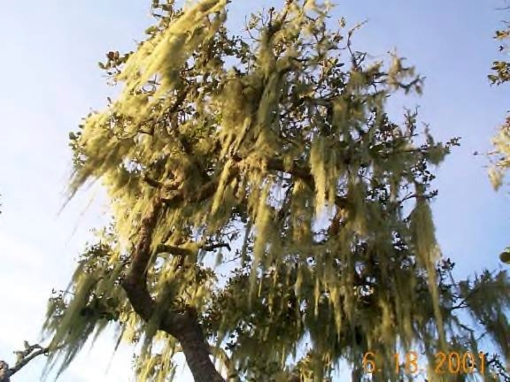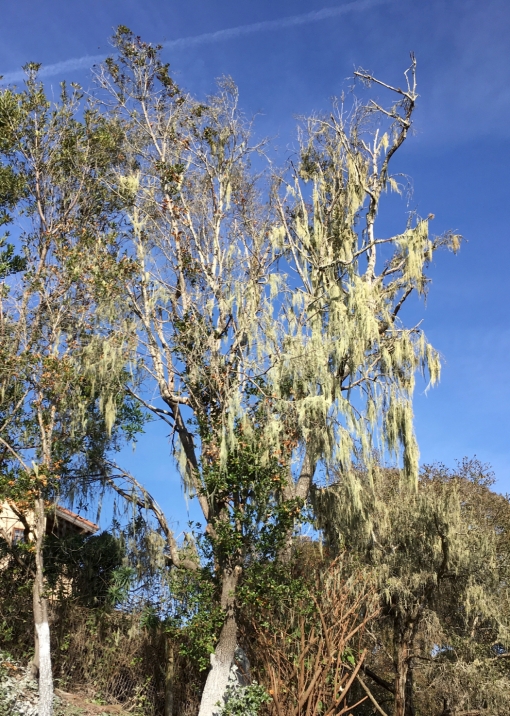
(image downloaded from web June 2013)
Any careful observer of oaks in California cannot help but notice a dense covering of lichens growing on the trunks and branches of many of the trees. In some cases, the biomass of lichens in the canopy rivals and even exceeds the biomass of the oak foliage. Under extreme conditions of lichen cover, the oaks appear sickly and in decline.

Coast live oaks covered in epiphytic Usnea and Ramalina lichens. (February 2018, Aptos, CA)
There is a popular meme in naturalist and conservation circles that lichens do not harm trees and merely use them for support. Adherents to this ‘harmless lichen’ meme point out that lichens are photosynthetic and, thus, do not draw any resources from the trees. Some note that lichens support nitrogen-fixing bacteria, which can add to the nutrient pool and benefit the trees. Furthermore, lichens are known to be highly sensitive to air pollution, so the presence of abundant lichens in a tree is a sign of good local air quality.
I have long been doubtful about the science behind this meme. As an experienced researcher of forest decline I have frequently noted that sick and dying trees often have a dense growth of lichens in their canopies. Defenders of the ‘harmless lichen’ meme describe this as the opportunistic growth of lichens on sick trees, as the reduced foliage allows for additional light for the lichens to grow. It is certainly true that lichens benefit from sick trees in this way, but I believe that lichens are not merely innocent bystanders or benefactors in the demise of a tree.
What is a lichen?
While classed as plants, lichens are symbiotic creatures, as are all organisms, in this case between one or more species of fungi, and one or more species of algae. Lichens may also contain certain species of bacteria and cyanobacteria. The fungus makes up most of the structural tissue of the lichen, and the algae and/or cyanobacteria comprise the photosynthetic tissue.
Lichens, including those that grow on trees and other plants (epiphytes) are grouped into three growth forms, crustose (crust-like), foliose (leaf-like), or fruticose (shrub-like or hanging). They typically have rhizoids (aka rhizines), root-like structures that anchor the lichens to the substrate. Lichens reproduce vegetatively, whereby both the fungal and algal components of the organism are dispersed together in reproductive structures called apothecia, soredia, and isidia.
All this information can be easily found in a botany textbook. But as is typical in science, there is much more to lichens than is discussed in textbooks.
Are lichens harmful to trees?
Let’s start with the basic biology of lichens. Lichens produce acids, including usnic acid, carbonic acid, evernic acid, oxalic acid, and various other organic acids. Lichens are known to greatly enhance the weathering of rocks through various biophysical and biochemical means. Given these findings, it is not unreasonable to wonder if lichens are involved in the breakdown of bark tissue or are otherwise disrupting the normal functions of the tree.
With regards to trees in general, and particularly oaks, the peer-reviewed science shows compelling evidence that lichens are harmful to tree health. Lichen acids and other compounds can breakdown bark, as well as inhibit photosynthesis, bud development, and leaf formation. There are also biophysical effects of the lichen rhizoids and thalli penetrating into the xylem and phloem of the tree.
Taken together, these studies (see below) tell me that the ‘harmless lichen’ meme should be seriously questioned.
One final point, during Native American times, when burning around the oaks was a common practice, the smokes and flames were effective controls against the buildup of lichens, as well as mosses, which also produce acids and breakdown bark. So the buildup of lichens and mosses on the oaks is a fairly new phenomenon brought on by the suppression of fires. They are an added stress to oaks which are already stressed by over-competition, nutrient poor soils, and diseases.
I’ve compiled a list of studies, with abstracts, that address the issue of lichens and tree health directly. They are, in no particular order:
1 – Harmful effects of epiphytic lichens on trees
By LEGAZ Maria-Estrella (1) ; MONSO Maria-Andrea (2) ; VICENTE Carlos
Recent research developments in agronomy and horticulture: Vol. 1 (2004)
http://cat.inist.fr/?aModele=afficheN&cpsidt=17181978
Epiphytic lichens can have harmful effects on trees on which they grow. Their hyphae readily tear off areas of both phloem and xylem and they disperse towards the vessels. Thallus penetration produces clear symptoms of chlorosis and ageing of leaves by inject metabolic inhibitors that, after translocation in the xylem sap, reach leaves and produce abscission. Lichen phenolics block the electron transport between QA and QB sites in the PQ region of thylakoid membranes by inducing conformational changes in a platoquinone-bound protein. Alternatively, they also produce the loss of chloroplastic manganese through a chelation process. For leaves in which lichen phenolics does not easily penetrate through the chloroplast membrane, these lichen metabolites conjugate to indole-3-acetic acid and the subsequent decrease of the amount of free auxin retards or impedes bud evocation and leaf development.
2 – Adverse Effects of Epiphytic Crustose Lichens upon Stem Photosynthesis and Chlorophyll of Populus tremula L.
Solhaug, K. A., Gauslaa, Y., and Haugen, J.
Botanica Acta 108:3 pp. 233-239 (1995)
http://dx.doi.org/10.1111/j.1438-8677.1995.tb00855.x
Dry cork layer (phellem) in stems of Populus tremula transmitted 35–55 percent of incident irradiation, depending upon moisture content. A cover of crustose Lecanora lichens reduced transmission through phellem to 10 percent or less of incident irradiation. The bark contains photosynthetically active cells. Apparent quantum yield for photosynthetic O2-evolution was 0.017 in bark covered with dry Lecanora compared with 0.070 in naked bark. The capacity for gross photosynthesis in high light (1090 μmol photons m−2 s−1) was reduced by 50 percent in Lecanora-covered bark. Lecanora did not reduce the ratio between variable and maximal chlorophyll a fluorescence (Fv/Fm). Chlorophyll content per unit area was similar in leaves and naked bark of Populus tremula. The chlorophyll content in the bark decreased with increasing chlorophyll content in Lecanora. Chlorophyll a/b ratio was 2.5 in the bark compared with 4.0 in leaves and in Lecanora, and the ratio decreased down the stems. The a/b ratio was 2.3 in Lecanora covered bark compared with 2.6 in naked bark. The changes in bark photosynthesis below a Lecanora crust were probably due to acclimation of bark photosynthesis to shade, since the lichen acids in the measured lichens neither suppressed photosynthetic O2-evolution nor changed the Fv/Fm in bark disks.
3 – Effects of lichen phenolics on defoliation of Quercus rotundiflia LAM.
Khalid BOUAID & Carlos VICENTE
Sauteria 9,1998 I A L 3 – Proceedings 229-236
Epiphytic lichens play a secondary role as pathological organisms against their phytophores on which they grow and, thus, it is a common practice to destroy corticolous lichens growing on fruit trees with fungicides. Branches of Quercus pyrenaica WILLD. and Quercus rotundifolia LAM. supporting a heavy population of epiphytic lichens are often largely defoliated. Medulary hyphae can penetrate into host tissues by both mechanical and enzymatic action, to reach xylem vessels. So far this can be due to a mechanism through which lichens inject metabolic inhibitors that, after their translocation in the xylem sap, reach leaves and produce abscision. Chloroplasts isolated from detached leaves of Quercus rotundifolia were incubated with lichen substances isolated from Evernia prunastri thallus that produced inhibition of the Hill reaction. In this report, we demonstrate that the incubation with lichen substances unhangs magnesium ions from chlorophyll and produces the liberation of phaeophytins. On the other hand, those lichen substances diminished the amount of chloroplastic manganese through a chelation process. These effects cause loss of photosynthetic activity because the Hill reaction is restored upon addition of exogenous magnesium and manganese to the chloroplasts.
4 – Epiphytic lichens inhibit the appearance of leaves in Quercus pyrenaica
MaEstrella Legaza, Elena Perez-Urriaa, A. Avalosa and C. Vicentea
Biochemical Systematics and Ecology Volume 16, Issue 3, 18 April 1988, Pages 253-259
doi:10.1016/0305-1978(88)90002-6
The lichen Evernia prunastri, epiphytically growing on trunks and primary branches of Quercus pyrenaica shrubs, into the xylem of its host evernic acid, which is acropetally translocated. This phenol inhibits both respiration and appearance of foliar buds, and also retards leaf formation.
5 – Chlorophyll degradation effected by lichen substances
By Khalid Bouaid & Carlos Vicente
http://www.sekj.org/PDF/anbf35/anbf35-071p.pdf
Epiphytic lichens can exert some negative actions on trees, since they penetrate to different degrees into several tissues of the phytophore. Evernia prunastri (L.) Ach. hyphae progress into xylem vessels of Fagus sylvatica, Quercus pyrenaica and Betula alba. This is on the basis of a mechanism through which lichens inject metabolic inhibi-tors in the xylem vessels, and, after their translocation in the xylem sap, they reach different organs of the phytophore and produce defoliation. In this report, we have noted that usnic acid is more impermeant than atranorin through the chloroplast mem-brane of Quercus rotundifolia leaves. On the other hand, we have also noted the degra-dation of chlorophyll in response to lichen substances.
6 – Chloroplast-ultrastructure and chlorophyll content in leaves from Quercus branches with and without epiphytic lichen thalli
C. ASCASO, S. RAPSCH
Plant, Cell & Environment, Volume 8, Issue 9, pages 651–656, December 1985
http://onlinelibrary.wiley.com/doi/10.1111/1365-3040.ep11611691/abstract
The effect that the massive presence of lichen thalli growing on the branches of Quercus pyrenaica and Q. rotundifolia leaves has on their chloroplasts been studied. In both species there were significant decreases in the amount of chlorophylls in the leaves of twigs with a dense cover of lichens in comparison with the leaves from thallus-free twigs. The areas and perimeter of chloroplasts in leaves from twigs with epiphytes did not differ significantly from those in leaves without epiphytes. However, in leaves with epiphytes the percentage of chloroplast area occupied by starch was higher. In Q. pyrenaica the number of grana per chloroplast section and per μm2, the percentage of chloroplast stroma occupied by grana, the average number of thylakoids forming grana and the grana width was significantly smaller in leaves near lichen populations. These results are discussed and related to the great chelating capacity of the lichen’s substances.
7 – Manganese depletion in chloroplasts of Quercus rotundifolia during chemical simulation of lichen epiphytic states
M. Isabel Orús, M. Filar Estévez, Carlos Vicente (2006)
http://onlinelibrary.wiley.com/doi/10.1111/j.1399-3054.1981.tb08503.x/abstract
Incubation of Quercus rotundifolia branches in culture media containing lichen substances isolated from Evernia prunastri thallus produces inhibition of Hill reaction in chloroptasts isolated from the leaves of the branches. Incubation with lichen substances diminishes the amount of chloroplastic manganese through a chelation process. This decrease causes the loss of photosynthetic activity because the Hill reaction is restored upon addition of exogenous manganese to the chloropiasts.
8 – Ultrastructural Changes in Chloroplasts of Quercus rotundifolia Lam. in Response to Evernic Acid
C. ASCASO and S. RAPSCH
Ann Bot (1986) 57 (3): 407-413.
http://aob.oxfordjournals.org/content/57/3/407.abstract
The amount of total chlorophyll, chlorophylls a and b as well as the ratio of a to b decreased in chloroplasts isolated from Quercus rotundifolia leaves, kept for 17 d in a solution of 35.5 μM evernic acid in 1 mM Na HCO3, when compared with the chloroplasts of control leaves (kept in NaHCO3). The chloroplasts in the spongy parenchyma were smaller and the amount of starch and plastoglobuli lower. The number of grana per chloroplast section, the number of thylakoids per grana and the height of grana stacks were also less in the chloroplasts of leaves treated with evernic acid. Quantitative ultrastructural differences were determined by means of electron microscopy and image analysis techniques.
We have some overlap of view…I linked your blog to mine https://treasurecoastnatives.wordpress.com/2019/05/09/are-lichens-tree-parasites/
Thanks for the link. I read you article and agree that we have a similar take on the problem of lichens and tree decline. Note that under a more frequent fire regime, as occurred during the time of Native Americans tending the land, there would have been far fewer lichens in the trees, as lichens are very sensitive to heat and smoke.
absolutely…sure wish I had a microtome setup